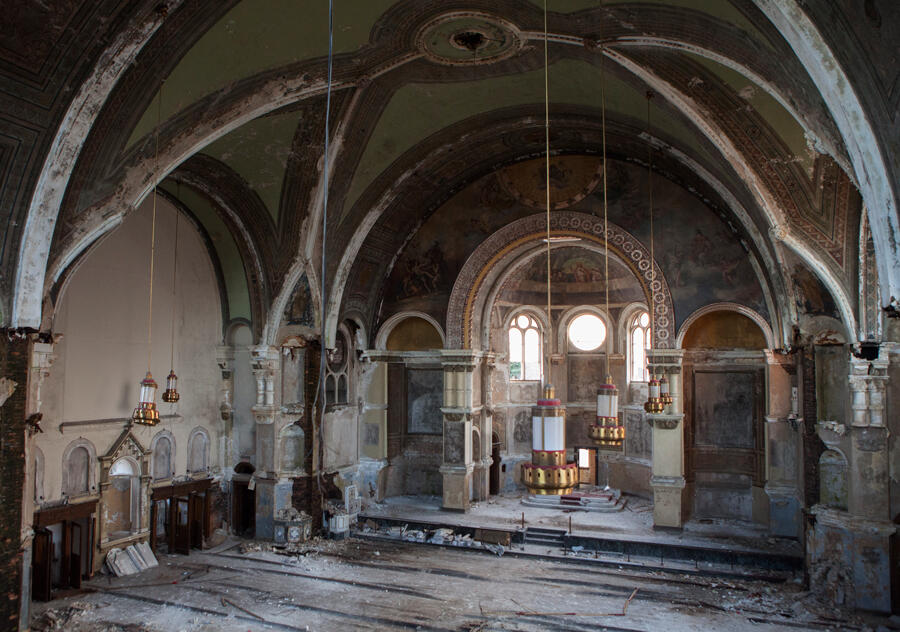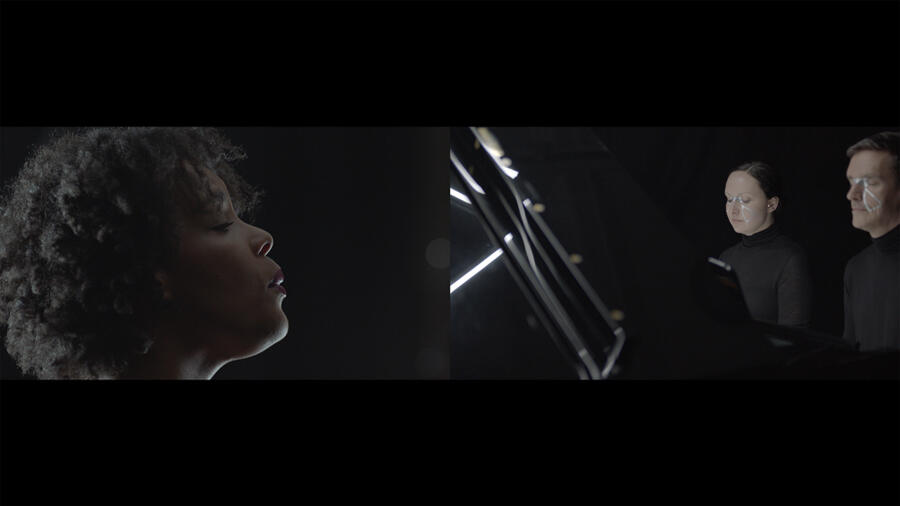‘Drum Listens to Heart’ Intuits the Unheard Rhythms of our Lives
A three-part exhibition at CCA Wattis Institute for Contemporary Arts, San Francisco, draws on the ensemble form and musical score to deliver a vision of cacophonous community
A three-part exhibition at CCA Wattis Institute for Contemporary Arts, San Francisco, draws on the ensemble form and musical score to deliver a vision of cacophonous community

Let’s start with the croaks. To experience Trisha Donnelly’s sound installation untitled (2009) in San Francisco this past winter, one had to schedule a private listening session, in which one was rewarded with the dulcet tones of a chorus of frogs, made from altered internet field recordings. A private aural moment between the artist and the viewer, mediated by the guttural sounds of amphibians, Donnelly’s installation was technically not ‘on view’ as part of the group exhibition ‘Drum Listens to Heart’ at San Francisco’s Wattis Institute. But the cool conceptualism and irreverent phenomenological character of the sound piece made itself heard as a sort of coda for a show that materialized what John Cage described in his ‘Autobiographical Statement’ (1990) as ‘the spirit of percussion’ – an ethos that ‘opens everything, even what was, so to speak, completely closed’.

More than five years in the making, ‘Drum Listens to Heart’ is the swan song of former Wattis chief curator Anthony Huberman, who departs the institution for the John Giorno Foundation after a decade of organizing groundbreaking exhibitions and a signature artist-centric study programme, which in recent years ranged from Vincent Fecteau and Trinh T. Minh Ha to Lydia Ourahmane and Cecilia Vicuña. Unfolding in three discrete stages over five months, ‘Drum Listens to Heart’ – which includes a suite of live performances organized by curator Diego Villalobos, held both in the exhibition galleries and in the nearby experimental performance venue The Lab – stands out as a rare, risk-taking thematic exhibition in a landscape dominated by blockbuster solo presentations and flashy, star-studded group shows. That’s not to say stars are absent here – heavy hitters in the roster include Francis Alÿs, Theaster Gates, David Hammons and Haegue Yang – but the exhibition takes its organizing principle of the ensemble form and the musical score seriously, allowing polyvocality to emerge both between individual artists in the show and within the flow of the tripartite programme. Anchoring all three elements of the shifting, dynamic exhibition is a vitrine of concrete poems by Susan Howe, taken from her book Concordance (2020), and a collaborative sound installation by Howe and the musician and academic David Grubbs (Concordance, 2022). The poetry marks an entryway to the Wattis’s reading room and bar, which is outfitted with selections from local record stores that are available for purchase.

In its opening notes, the exhibition establishes what Huberman defined in his excellent, historically rigorous catalogue essay as ‘the percussive’. Distinct from ‘rhythm’, the percussive indexes extralinguistic, undisciplinary social modes of organization often found in non-Western and colonized cultures. Here, it is best articulated in Marcos Ávila Forero’s video of indigenous Afro-Colombians performing a collective water-drumming ritual on the Atrato River in Colombia (Atrato, 2014). As both complement and counterpoint, Milford Graves’s assemblage Pathways of Infinite Possibilities (2017) features medical skeletons outfitted with West African dùndún drums and small monitors looping videos of open-heart surgery, evocatively melding together the particularities of cultural expression with the universalizing pulse of human life in a way both elegiac – Graves died in 2021 – and winsome. The pairing of Lee Lozano’s painting of a three-pronged hammer (Untitled, 1963) with Barry Le Va’s installation of shattered panes of glass (1 Edge/2 Corners; 2 Edges/1 Corner, 1968–71/2022) felt funnily and uncomfortably literal to the percussive theme, the straining of the curatorial conceit a cheeky reminder of the exhibition’s eclectic range.

The second movement is accompanied by a radical reorganization of the exhibition space, darkened to accommodate the all-video checklist, with each of the works audible through headphones that prevent noise from bleeding into adjoining galleries. If the first part of the exhibition felt, at times, cacophonous from the physical and conceptual crowdedness of so many voices, this iteration’s radical reduction of form gives the viewer a heightened awareness of the individual body as receiver and processer of sensation – one that can temporarily create new coalitional forms. Alÿs’s Guards (2004) illustrates this quite literally: a camera trails 64 red-coated members of the Queen’s Guards as they march through the streets and across the bridges of London, easing into and breaking off from rigid phalanxes. It pans down their bodies and rests on a close crop of their boots as the viewer takes in the staccato rhythm of their stomps – a discomfiting reminder of how the enforced maintenance of regular patterns marks the disproportionate power of a state. More discomfiting is the stamp that announces, at the end of the film, that the work was created ‘with the full cooperation of the British Army’ – a declaration all the more jarring for its banal revelation of what other kinds of bodies (bureaucratic, undocumented, carceral) can mark rhythm and time.

Yet, if the ensemble is characterized by its ability to marshal temporary coalitions in space and time, then it stands to reason that it can also create alternatives, however ephemeral, to hegemonic order. That became clear when I attended a performance at The Lab by Nkisi in late November last year, where the London-based sound artist and DJ worked an audience through a textured, synth-heavy set. I felt the artist create an atmosphere in real time, a sonic environment that held together an otherwise motley audience for an hour before they spilled back into the regular tempo of their lives. Throughout the run of the exhibition, performances by Raven Chacon, Moor Mother Ensemble, Music Research Strategies, and Karen Stackpole and Gino Robair offered additional spaces for convening. Both Chacon’s American Ledger No. 1 (2018) and Music Research Strategies’ Ebonics Native Land Acknowledgement (2021) transformed the dynamic between performer and viewer into one of collective witnessing and communal study. Chacon’s performance deploys the flag as a frame through which the story of indigenous dispossession at the hands of settler colonists could be narrated as the story of America, while the metronymic patter of the drum in Music Research Strategies’ performance held in abeyance a polyvocal reading of the United Nations Declaration on the Rights of Indigenous Peoples (2007). The power of the ensemble here lies in the co-created rhythm, demonstrating the importance of sharing space in the present.

A similar combination of corporeal resonance and improvisation guides the final, and by far the best, section of ‘Drum Listens to Heart’ – a success no doubt due to the more playful, conceptually open organization of works that brought new air to the space. Small, battery-powered machines by Rie Nakajima keep time with their slow crawl and buzzing (Kaeru Oto (Sound, returning), 2022), while Consuelo Tupper-Hernandez’s tearaway scores for a taxonomy of applause offers a language for collective expression (Applause Dictionary, 2020/2022). NIC Kay’s looped selections from their archival project #Blackpeopledancingontheinternet (2021–ongoing) plays on a wall-mounted iPhone abutting a school desk drilled to the gallery wall, pairing wonderfully with Gong, an undated video by David Hammons, in which the artist keeps time with construction workers using power tools on the street, joining the din with makeshift instruments and thereby blurring the boundaries between noise and music.

Understood in this way, the ensemble aids us in imagining dissensus without enmity or, as articulated in the exhibition catalogue, community without harmony: to resonate in the present climate without resorting to vague, hackneyed admonitions; to simply listen to one another better. The rhythm of this exhibition is intuitive: rooted in a deep attentiveness to space, time and everyday life.
‘Drum Listens to Heart’ is on view at the CCA Wattis Institute for Contemporary Arts, San Francisco, until 4 March.
Main image: Marcos Ávila Forero, Atrato, 2014, film still. Courtesy: the artist

























